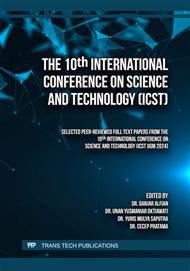p.586
p.595
p.610
p.628
p.642
p.652
p.662
p.672
p.685
Multi-Level Remote Sensing Imagery to Study Land Use Changes in the Strategic Area of Yogyakarta International Airport
Abstract:
The construction of the airport triggers changes in land cover. These changes can be identified using remote sensing technology. The change analysis is conducted using Sentinel-2 imagery with a resolution of 10 meters. However, the results of the analysis are still quite general, as the imagery used cannot directly provide detailed information about the types of land use that are evolving. Therefore, based on the land cover changes, areas with the most dominant changes are selected for further analysis. These areas are then analyzed using very high-resolution imagery to determine the specific land use changes in 2022. The aim of this research is to map land cover changes in 2016-2022 using medium-resolution imagery in the YIA Strategic Area and examine the types of land use changes using high-resolution imagery in the Strategic Area of YIA based on the results of land cover changes. Land cover maps for 2016 and 2022 were obtained through multispectral classification using maximum likelihood algorithm on Sentinel-2 imagery. The overlay of both land cover maps indicates a decrease in the area for fields/fallow land, mixed gardens, ponds, rice fields, and open land. On the other hand, there was an increase in the area for residential buildings, roads, airport areas, and buildings used for industry, commerce, and offices. Based on the results of the hotspot analysis, the concentration of changes occurred around the airport, especially from non-building land cover to residential buildings, commercial industrial and offices. Detailed analysis using high-resolution satellite imagery (HRSI) show that the dominant objects that have developed include residential houses and boarding houses, residential complexes, hotels, schools, public facilities, healthcare facilities, and offices. Residential complexes, boarding houses, gas stations, hotels, schools, offices, and religious and health center were closely related to the presence of airports. Several objects were built because of the relocation of airport construction. For residential buildings, several objects were built because of the presence of the airport, and some were built because of personal interests.
Info:
Periodical:
Pages:
642-651
Citation:
Online since:
October 2025
Authors:
Price:
Сopyright:
© 2025 Trans Tech Publications Ltd. All Rights Reserved
Share:
Citation:


